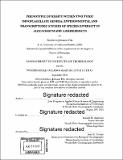| dc.contributor.advisor | Donald M. Anderson. | en_US |
| dc.contributor.author | Pitz, Kathleen Johnson | en_US |
| dc.contributor.other | Woods Hole Oceanographic Institution. | en_US |
| dc.date.accessioned | 2017-01-30T19:16:02Z | |
| dc.date.available | 2017-01-30T19:16:02Z | |
| dc.date.copyright | 2016 | en_US |
| dc.date.issued | 2016 | en_US |
| dc.identifier.uri | http://hdl.handle.net/1721.1/106735 | |
| dc.description | Thesis: Ph. D., Joint Program in Applied Ocean Science and Engineering (Massachusetts Institute of Technology, Department of Biology; and the Woods Hole Oceanographic Institution), 2016. | en_US |
| dc.description | Cataloged from PDF version of thesis. | en_US |
| dc.description | Includes bibliographical references (pages 124-131). | en_US |
| dc.description.abstract | Dinoflagellates are a diverse group of single-celled eukaryotic phytoplankton that are important for their unique genetics and molecular biology, the multitude of ecological roles they play, and the ability of multiple species to produce toxins that affect human and ecosystems health. Two dinoflagellate genera, Alexandrium and Gambierdiscus each contain species that can cause human poisoning syndromes, although the methods of toxin transfer, accumulation, and exposure are very different. Gambierdiscus is a benthic organism that produces lipophilic ciguatoxins that can bioaccumulate in coral reef fish and cause ciguatera fish poisoning (CFP) in human consumers. Alexandrium is a planktonic species that produces saxitoxins that can directly accumulate in shellfish and cause paralytic shellfish poisoning (PSP) in humans. Both genera contain multiple species that vary dramatically in toxicity and physiology. Through transcriptomic analysis, this thesis describes the genetic diversity present across dinoflagellates that produce saxitoxin, elaborating on differences in their complement of genes within the saxitoxin biosynthesis pathway. This study demonstrated retention and expression of some of these saxitoxin genes by non-toxic species within Alexandrium, as well as in Gambierdiscus, which does not produce saxitoxins. Furthermore it confirmed the presence of certain transcripts only in toxin-producing species. This thesis then developed novel fluorescence in situ hybridization (FISH) probes that can be used to identify and enumerate six Gambierdiscus species, thereby enabling the community composition of Gambierdiscus to be examined in a quantifiable manner. The probes were tested in the laboratory on cultures, and then successfully applied to field samples from Florida Keys and Hawai'i. Gambierdiscus species are diverse in both their toxicity and optimal temperature ranges for growth. Analysis of Gambierdiscus community composition in an area of variable temperature allowed the characterization of species shifts that were driven both by a seasonal increase in mean seawater temperatures and spatial variability of temperature experienced between tidal pools. Overall this thesis advances the knowledge of dinoflagellate genetics and ecology, aids in the characterization of species harmful to public health, and provides tools and approaches to help monitor and manage harmful effects from these species, including some that are projected to increase with climate change. | en_US |
| dc.description.statementofresponsibility | by Kathleen Johnson Pitz. | en_US |
| dc.format.extent | 131 pages | en_US |
| dc.language.iso | eng | en_US |
| dc.publisher | Massachusetts Institute of Technology | en_US |
| dc.rights | MIT theses are protected by copyright. They may be viewed, downloaded, or printed from this source but further reproduction or distribution in any format is prohibited without written permission. | en_US |
| dc.rights.uri | http://dspace.mit.edu/handle/1721.1/7582 | en_US |
| dc.subject | Joint Program in Applied Ocean Science and Engineering. | en_US |
| dc.subject | Biology. | en_US |
| dc.subject | Woods Hole Oceanographic Institution. | en_US |
| dc.subject.lcsh | Dinoflagellates | en_US |
| dc.subject.lcsh | Phytoplankton | en_US |
| dc.subject.lcsh | Ecology | en_US |
| dc.title | Phenotypic diversity within two toxic dinoflagellate genera : environmental and transcriptomic studies of species diversity in alexandrium and gambierdiscus | en_US |
| dc.title.alternative | Environmental and transcriptomic studies of species diversity in alexandrium and gambierdiscus | en_US |
| dc.type | Thesis | en_US |
| dc.description.degree | Ph. D. | en_US |
| dc.contributor.department | Joint Program in Applied Ocean Physics and Engineering | en_US |
| dc.contributor.department | Woods Hole Oceanographic Institution | en_US |
| dc.contributor.department | Massachusetts Institute of Technology. Department of Biology | |
| dc.identifier.oclc | 969340481 | en_US |
